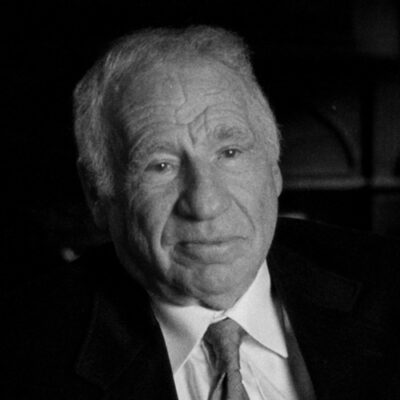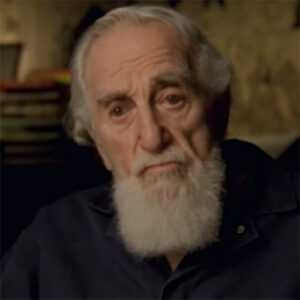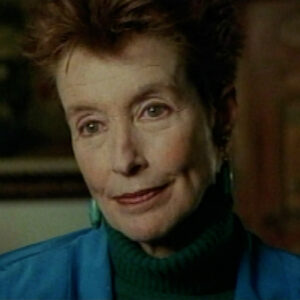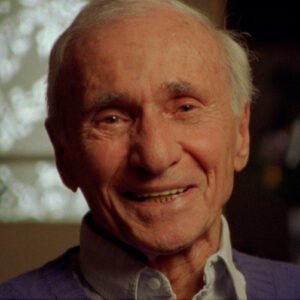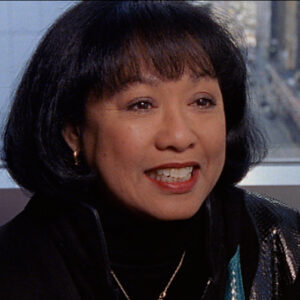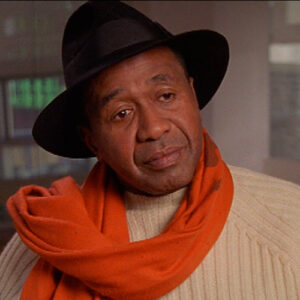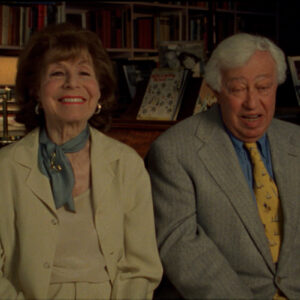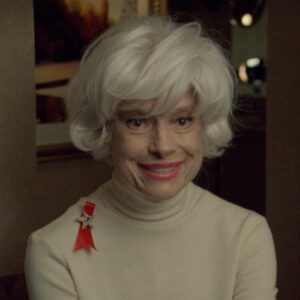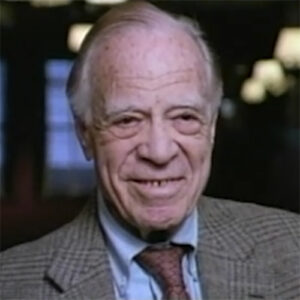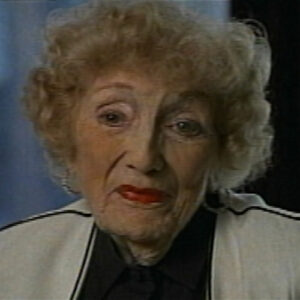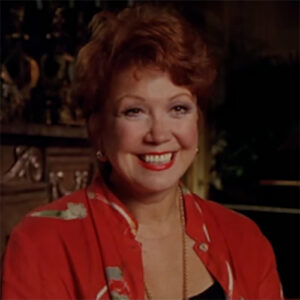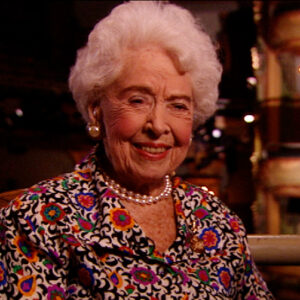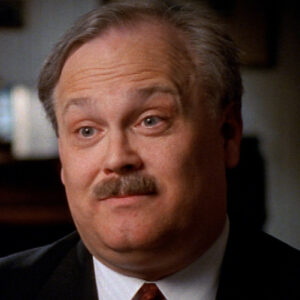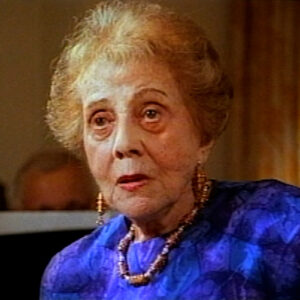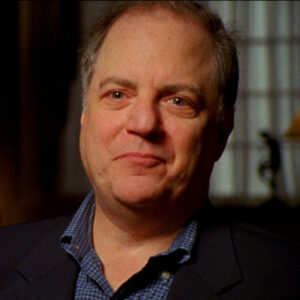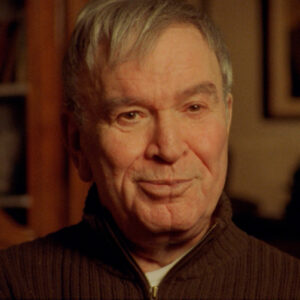Miles Kreuger: At the turn of the century, most Broadway musicals were actually imported from England. There was a lovely theater in England called The Gaiety, and a lot of the shows that came over came from The Gaity Theater. They were very piquant, very charming. They generally tended to be a leading lady of considerable beauty and charm with a nice singing voice. There were always roles for comedians, especially low comedians. The typical drunk and the typical funny older man, the scatter brained professor type character and that sort of thing. Shows were very stereotypical in terms of the way they were constructed. They were usually in three acts. There was always the song, the romantic song for the boy and girl in act one and then there was the obligatory follow up love song in act two and then sometimes a reprise in Act 3. Then there was a song for the ingenue and the juvenile, and they were just really almost in form, cut out of cookie jars, cookie cutters. They were amazingly stereotypical, and people didn’t go expecting originality. They went expecting charm and expecting qualities that we don’t even have in the American musical theater anymore. We don’t think about things like beauty and grace and elegance and young ladies being coy. And women wearing clothing called frocks. That kind of delicacy, that kind of chiffon attitude toward women just simply doesn’t exist anymore. And that was really part and parcel of the American musical at the turn of the century.
Michael Kantor: Who are the Schubert Brothers and how did they change the face of Broadway theater?
Miles Kreuger: The Schubert brothers came from Syracuse, New York. They weren’t very well-educated, and they were rather rough. And they ran little theaters until they decided to get to Broadway. And then they began to rent theaters on Broadway. And pretty soon, they decided to anchor themselves in town and become major players. And that meant coming up against Claw and Erlanger in the so-called syndicate. And the syndicate was very much like the the arguments today between union and non-union people, you know, and the syndicates control not only the theaters in New York, but also most of the important theaters throughout the rest of the United States. So that if a show toured, it tended to tour from a syndicate theater in New york to syndicate theaters throughout the rest of the country. And the Schubert’s had to buck all of that. They were the mavericks. And, of course, ironically, by bucking them, they became so huge that, in a sense, they became their own syndicate.
Michael Kantor: What about the way performers, what they had to provide? Give us a sort of broad strokes look at what a life of a performer was before unionization.
Miles Kreuger: In the early years of the century, there was more live theater than one can even conceive today. Every town, every city, every hamlet had theaters, live theaters, repertory companies, theaters that housed touring companies. You must remember, of course, there was no radio, no television, and there were no movies. And so, live theater was the entertainment of choice. And there was an enormous amount of work. And people who had talent honed their crafts generally out of town. When they were young performers, they wanted to be singers. They wanted to the actors, whatever they wanted to be, they had places where they could fall flat on their faces and make fools of themselves. And it didn’t much matter because they weren’t being scrutinized by New York critics. And so there was enormous amount of work there was no actor with any talent was ever out of work for long. However When you went to work for a producer and you signed a contract, it was not unlike the movie stars later because the movie studios simply emulated what theater had been. People signed contracts. People like John Drew and others were, let us say, contracted to Froman, Charles Froman who was one of the major producers of his day. And it was like Betty Davis signing with Warner Brothers, for example. And they had no rights, particularly. But the more they brought people into the houses because of their reputations and because of their talent, the more bargaining power they had. And so stars had tremendous bargaining power. And they were lionized. They were worshiped. There were magazines galore about theater stars, just as there are today about television and movie stars.
Michael Kantor: Lillian, I mean, who were the first biggest stars?
Miles Kreuger: Well, the great stars, for example, of the great stars of the 1890s would be people like Lillian Russell and, well, in musicals. Lillien Russell and Fay Templeton and so on. And then shortly after the turn of the century, Anna Held, Blanche Ring. There were just so many. Vera Michelina. There were countless stars. We’d be sitting here forever just listing them, if I listed all of them.
Michael Kantor: What did they become known for in the public eye? And how did they influence American culture? Not just… The stage, but in terms of other areas, fashion.
Miles Kreuger: Much of our social life in this country in the teens was altered by the existence of two remarkable people, Vernon and Irene Castle. Vernon Castle was a Brit who at the time he met his wife, was working as a low comic, as a foil really for Lou Fields of the comedy team of Weber and Fields. And He met this lovely girl named Irene Foote, who lived up in Yonkers, New York. And she was appalled that this man had so much grace and elegance that he was wasting his time in her mind by being a comic, even though he was quite successful on Broadway. And so they began to dance and they revolutionized social dancing in this country and ultimately in the world. Actually, it started in France. The first time they were discovered was in the Casino de Paris in Paris. And they introduced to the world the foxtrot, the machicha, the hesitation waltz, the one step, all the dances that were graceful as in contrast to the kind of jiggly ragtime dances of the period. And when they hit Broadway, it was just unbelievable. It revolutionized everything. They had. The castle house where they actually had tea dances and where you could go for dance training Her costuming altered feminine costumes She cut her hair and all the women in America cut their hair and bobbed their hair for the first time ever This was considered scandalous in its day. I mean women didn’t have long hair. They had I mean short hair They had long hair piled up on top of their heads And the Castles were tremendously influential too in introducing jazz into accompanying social dancing because they had a black band leader named Jim Europe who just recorded for Victor Records and his whole style was much more spirited, much more jazz-like, although muted really, wasn’t really wild jazz. Uh… Than anything anybody had ever heard before and so the castles were revolutionary in the in nineteen fourteen fifteen sixteen in that period
Michael Kantor: But tell me what ended their, how did their partnership end?
Miles Kreuger: Because World War I had begun, Vernon felt that as a British citizen, he ought to join the war, even though the United States wasn’t in the war yet. And so he did so. And tragically, he was killed in a plane accident in Texas just before World War II, World War 1 ended. And of course, The world was devastated, and Irene was devastated. And she went on and made silent films for a while and did a few other things, but basically drifted into retirement as a performer and then turned her attention to something that she adored, which was saving dogs that needed homes. And she had a place in Chicago called Orphans of the Storm taken from the D.W. Griffith movie. And that’s where I visited her many times. And she was remarkable. She hated vivisection. And in those days, rabies shots were frequently fatal, even for a healthy dog, because they used a live virus. And she didn’t believe in any of that. In 1911, Berlin wrote a song called Alexander’s Ragtime Band that was just introduced as a popular song. It’s not from a show or a film or anything. And That song caught on and became an international craze. Its syncopation was so fresh and so different from anything that people were hearing at that time. And there was a kind of a sassy attitude that it had that was very typical of young Irving Berlin. And people had to have more and more and and more. And so Berlin instantly was on the map as a songwriter. And then, of course, everybody had to follow and try to write something that was similar. And pretty soon, we had ragtime Broadway shows. And in 1914, Irving did his first one, which was Watch Your Step, which opened at the New Amsterdam Theater. And it’s interesting because not all the songs in Watch Your Stepp have that kind of ragtime quality. Many of them are romantic ballads and comedy songs and things like that. But it really put that man on the map. And if there’s one genius in the songwriting world in the 20th century, it is surely Irving Berlin. It’s so hard to pick specific landmarks and say that this is the first of anything because if you look a little bit earlier, you’ll always find a precedent for something, you know. And people always say, oh, the Black Croak is the First Musical. Well, of course it isn’t. The first American musical, because it is literally the first, was The Archers by William Dunlap with music by Benjamin Carr and it opened in the 1790s. It was the first musical professionally produced after the Revolution, during which time, by the way, all the theaters were closed. And interestingly enough, The Archers was a show in the style of an English ballad opera, like the three, not the three-penny opera, but the beggars’ opera. And it was about a freedom fighter. It was about William Tell. And I think two.
Michael Kantor: What about a girl from Utah? How do you feel about that? Is that a landmark?
Miles Kreuger: The Girl from Utah isn’t a landmark in itself. It was an English musical, after all, by Sidney Jones. But when it came to Broadway, it contained a song that indeed was a landmark song. Jerome Kern was asked to write a few interpolations into the score to give it a sort of an American quality. And he wrote a song that I regard as the single most important song that has ever been written for the American musical theater till this day, and that is They Didn’t Believe Me, which was introduced. By Julia Sanderson. And the reason that it was so important is that it’s a song that is so totally conversational that it really glides out of the dialog that precedes it. The song is performed, much applause, and then it glides right back into the dialog. And that sense of integration was revolutionary in 1914. And led Elizabeth Marbury, who was a remarkable woman, one of the first literary agents in the world, to come up with the idea for the tiny little Princess Theater on 39th Street and 6th Avenue, a theater that was so small that you couldn’t have big spectacular shows in it, because there just wasn’t room. It had only 299 seats. And so she recommended Jerome Kern to write a series of shows. That today we think of as the princess theater shows, that relied on logical plots and songs that grew gracefully like they didn’t believe me in and out of the situations. This was revolutionary. And so while the Girl from Utah wasn’t a landmark show, the song was, and then the shows that came from it, very good Eddie, for example, and more… Particularly Oh Boy in 1917, those were landmark shows, because the entire scores were constructed in that fashion. Tom Curran was a remarkable man. He was born in New York City in 1885 and brought an air of civility to the level of musical theater writing that I don’t think it had ever achieved before in this country. And much of his early work was done for the British stage. The British thought he was very American, then of course reciprocally the Americans thought he was British. And it really shows that at that time many of the qualities of our respective countries in terms of social life and attitudes were very similar. People behaved politely and in a rather formal fashion, but a graceful fashion. And So he was able to make those transitions at a time when most composers didn’t. They either worked in one country and their shows were imported to America or so on. But Kern, I think, inspired very civilized lyrics and very civilize writers to do their best. People did their best when they worked with Kern generally. And at the Princess Theater, he worked with two Brits, uh… Guy bolton and P.G. Woodhouse, and their work is just exemplary. It doesn’t much matter that they were born in England. Who cares? They were writing in America, and they were writing for similar publics in both countries.
Michael Kantor: How is the history of American musical theater quite simply divided into two eras?
Miles Kreuger: Well, the history of the American musical theater is divided quite simply into two eras, everything before Showboat and everything after Showboat. It’s by far the most important musical that has ever been written for this theater and I think ever will be. Before Showboat, by and large, the subject matter was very light and not very profound. Shows often were about young chorus girls who wanted to become stars. Students, as in the case of Good News, who want to play football, but before they can play football they have to pass their astronomy test. You know, that kind of thing. It was very simple-minded. And while some marvelous writing may have taken place and there may have been tremendous integration, basically it was very lightweight work. When you came to Showboat, something very, very profound and very different occurred. First of all, Edna Ferber’s novel deals with an entire history and an entire epoch in American history. It begins just after the Civil War and goes all the way up into the late 1920s. No musical before had ever encompassed that kind of a time spectrum. So, first of all dealing with a long period of time is one thing that was new to Showboat. Then you have the character of Magnolia who begins as a teenager, innocent, protected, living her entire life on a floating, in a floating community where she barely has time to be touched by the outside world except when the showboat is tied off at a dock somewhere and the people come on board and then later they leave and go floating down the river again. All her social values, all her… Moral values come from the 19th century melodramas that are performed on the showboat. And so she’s very innocent. And the show follows a trajectory in which she grows up and matures before the audience’s eyes. Something that was understood in all literature and something that was understand for years in non-musical theater. But it never happened before in musical theater. So number two is we have a protagonist, in this case Magnolia, who evolves and matures right before the audience’s eyes. Then we have the character of Julie. Julie, it turns out, is revealed to be partially black. She is a mulatto that was illegal, literally illegal in the South in the 19th century. And so we have whole subject of miscegenation. And it is not treated comically or lightly as it is in Whoopie, for example, or Golden Dawn, which were other shows of the same period. It’s treated tragically. And so now we have the subject of miscegenation, a third subject that no one ever touched upon. We have alcoholism. She becomes an alcoholic, but it’s not the kind of funny red-nosed alcoholic drunk that, let’s say, James Barton and other comics were. In vaudeville and they would do funny falling-down acts, this is a tragic story. When Julie chooses in Act Two to sacrifice her job and give it to Magnolia, who doesn’t know she’s receiving Julie’s job after all, we think that it’s almost inevitable that Julie is going to be found face down in a puddle somewhere, dead, in a week or two, because she’s going to continue drinking until she’s dead. And that’s very serious. So there’s another subject. There are just so many remarkable things. It is the first show in which, for example, a black and white chorus and black and White principles interplay. And the opening chorus is astonishing. It opens with [Unrecognized] all work on the Mississippi, niggers, all work while the white folks play, loading up boats with the bales of cotton, getting no rest till the judgment day. This was intentionally designed to startle 1927 Broadway theater goers. Into realizing that this was something coming up that’s going to be extraordinary, something without any precedent whatsoever. And it has continued to startle people till this day, as well it should. And of course, that’s the only proper opening for any version of Showboat. And I really condemn any version of Showboat that doesn’t begin that way, which means I condemn every one of them since 1932. The first thing that Siegfeld accomplished by doing these remarkable annual follies. Was to create an ensemble of stars. And you have to remember that no one was ever starred in a Ziegfeld Follies. People always say, oh, Eddie Cantor starred in the Follys. He didn’t star in the follies. No one ever got star billing, or any billing whatsoever. But what he did was create stars. And around 1920, he began to realize that he could move to one step higher than producing annual reviews. And that is to produce big book shows. Built around the stars that he himself had created. So he started in 1920 with Sally, and Marilyn Miller and Leon Errol were the stars of that show. And in the cast was Walter Catlett, and there were several others who emerged off on the follies. And then came shows built around W.C. Fields and Eddie Cantor and so on. And what was astonishing about Showboat, of course, was that there were no stars in Showboat. Showboat was based on a concept, on a literary property. The book had come out in 1926, and Jerome Curran bought a copy of the book, at once began to see it as a musical, which is astonishing. I mean, that does tell you something about Curran, that he would even think that this could be turned into a musical. And went to Oscar Hammerstein, with whom he had collaborated for Charles Dillingham on Sonny in 1925. And up to that time, Hammerstein had never worked alone. He had always collaborated with Otto Harbach, who was older and who was very much his mentor. And he thought that this was the time for Hammerstein to flower and asked him to collaborate. Well, they wrote most of the songs of the first act and brought them to Ziegfeld. Who else would you bring them to? He was God. He was the greatest producer of his time. And he was the only man they felt who had the vision and the power and the influence to be able to put it on. Ziegfeld at once leaped to do it. There’s a great myth on Broadway that it took years for Ziegfel to decide. He took no time at all to decide, and I wrote a book in which I dated the day in which Kern got the rights to the show and the day on which Ziegfelt signed to do I mean, it was just a matter of weeks. What startled people was that Ziegfeld wanted to produce the show right away. It was commonplace for a Broadway show to be written in just a few weeks in those days because they were so simple, you know. Showboat took longer. It took longer because Hammerstein was evolving through the writing of this show into a writer for musical theater of great magnitude. And if you read all the early drafts that Hammerstein wrote and discarded, you can see a man evolving into becoming a major writer on just one property, which is astonishing. Usually, it takes many, many shows and a few failures and so on. Here, he had the sense of self-discipline that was so extraordinary. He would write a script and that wasn’t good enough. Meanwhile, Ziegfeld never got to see these versions. And he kept sending them telegrams. He loved telegram. And, you know, where is Showboat? Where is Showboat? And they kept postponing it and postponing. It took a year before they were ready. A year. This was unheard of in the whole history of the American musical theater. It’s interesting that I think sometimes events that are forced upon you, compelled you to grow. And Siegfeld. Had fallen into a certain pattern of producing first the follies and the teens, and then although he continued to produce them in the 20s, they weren’t terribly important in the 20s. Other things were happening to the form of the review in the twentys, making the follies almost kind of extraneous. The book shows that he was producing were very much of a style. Built around stars, very loosely constructed, lots of comedy, lots of pretty girls, some very nice songs occasionally. Showboat was so strange and so alien to him that I think he, I don’t think he knew what to make of it. And Goldie, his secretary who worked with him back to the early 1920s, said he was always uncertain. That this show was going to work. First, he was uncertain because he couldn’t understand why Kern and Hammerstein took so long to write it. Then the show went out of town, and although it got rave reviews wherever it went, he himself didn’t understand it. He hated Old Man River, for example. It was too serious for him. And opening night, there was no applause at the Siegfeld Theater. Goldie said, a number would finish, and there’d be a few polites. Claps. People didn’t respond. They were paralyzed. They’d never seen anything like this before, because there had never been anything like it before. They weren’t prepared for that. They were prepared to see a girly show. It was the Ziegfeld show of the season. And when it ended, Ziegfel had done something. Actually, Hammerstein, who directed it, had done very, very revolutionary. The curtain went down at the end and never went up for curtain calls. There were no curtain calls in the original production. So the audience didn’t know what to do, and they applauded politely and walked out into the night. And Ziegfeld sat on the steps, going up to the balcony with Goldie, and was convinced he had a failure until the following morning when the reviews came out and they were hailing this work as something unbelievable. And then, and only then, when he looked out the window and saw the cues around the block. Did he realize he had the hit of his career, a show for which he would be remembered always. Tess Gardella was a vaudevillian who always performed in blackface in the character called Aunt Jemima. And as Aunt Jemaima, she was cast in the marvelous role of Queenie. It gave her the opportunity to sing Can’t Help Lovin’ That Man and Hey, Feller and Come On, Folks. And she had a great big booming voice and she was wonderful. And there were many people. Who thought she was a genuine black person, but indeed she was an Italian named Tess Gardella. And with the money that she made from Showboat, she actually invested in a pasta factory and you can’t get more Italian than that, I don’t think.
Michael Kantor: What’s happening in Queenie’s Ballyhoo, just because there’s that great old clip of that moment. Just very briefly help us understand that scene.
Miles Kreuger: Well, the showboat audience, of course, is mixed. It’s black audience and a white audience. That is to say the people in the town who are going to the boat. The blacks of course were expected to sit in the balcony and be segregated, but they were part of the audience. And so Captain Andy tries to encourage the blacks who are on the levee to come to the show and Queenie admonishes him and says, you don’t know how to talk to my people. And she goes into this wonderful, wonderful rousing number called Come On Folks. And by the end of that, she’s got them all worked up and they’re all excited and they all run off and buy tickets. Helen Morgan was one of the great icons of the 1920s. She had been a beauty contest winner actually in Canada. And she began to sing in cabarets. And in those days, cabaret often had very small dancing floors. And sew sheet. Got onto the piano and sat on the piano, cross-legged, and would sing her songs there. And that became somehow part and parcel of her act. She always had to perform sitting on a piano. And she was a hopeless alcoholic. She drank constantly and fronted a number of speakeasies, but she never really owned any of them. She was always employed by the gangsters who really owned them. She had appeared in a few shows earlier and when they needed an actress to play the character of Julie, she was absolutely perfect because she brought to it a kind of world-weariness even though she was only 25 years old at the time. All the reference books say she was born in 1900 and I’m embarrassed to say even my book does, but it turns out she was really born in 1902. So in Showboat she was all of 25. And in the 1936 film version, she’s only 34 years old and she looks so worn out and she died in 41.
Michael Kantor: And she’s, just in one line, she’s immortalized for her performance in Shell Boat, doing
Miles Kreuger: In Showboat, of course, she found her immortality, as so many people did, and her performance of Bill is one of the great moments in the history of the American musical theater. Oscar Hammerstein told me a story about Old Man River, which I think is kind of funny. Everybody reads all kinds of things into Old Man river. Oh, it’s so symbolic of this and it’s symbolic of that. And recent revivals have had Joe sing it looking solemn and looking historical and looking everything. Hammerstein said we had the song in the show for one reason and one reason only. Set changes were very loud in those days because the sets rumbled on very primitive casters as they were wheeled off and on the stage. And from a big, elaborate act one scene one, which was the levy in Natchez, we had to go to an intimate kitchen scene, act one, scene two, and we needed something very loud to cover the scene change. The role of Joe in Showboat was conceived for Paul Robeson, who was one of the most remarkable figures of his time. And because it took so long for the show to be written, Robesom, who was very much in demand, was finally unavailable. By the time the show went into rehearsals. And so Jules Bledsoe, who was a very good black singer, got to play the part of Joe for the first time and therefore introduced Old Man River. But when the show opened a few months later in London in the spring of 1928, Robeson finally had the opportunity to play it and was worshiped by the English. I mean, he was invited everywhere. He was given concerts, everything. His reception was simply unbelievable, the kind of thing that never would have happened in America because the British weren’t racist at all. And so in the 1932 Broadway revival, he played the part. By this time, Bledsoe himself had gone to England to live there. And then when the 1936 Universal Film version was made, of course Robeson again played the parts. And thank God we have that on film. Carl Lindley, Jr., who produced the 1936 film version for Universal, told me that it was his desire when making this second film version of Showboat to cast it with as many alumni as he possibly could from the original show. And so it’s marvelous to think that we have Helen Morgan and Charles Winninger and Sammy White and that wonderful rubber face, Francis X. Mahoney, recreating all their original roles. We have Irene Dunn who replaced the original Norma Terrace as Magnolia in the national tour playing the part of Magnolia. We have Alan Jones who was in the 1934 St. Louis municipal opera version. He hadn’t done it on Broadway. He was too young, of course, but the show has a ring of authenticity because there are so many people who are in the original cast or had played Showboat in some stage version.
Michael Kantor: In the Trocadero, you know sequence in which Julie sings Bill that’s very similar. Is it not to the Broadway?
Miles Kreuger: Oh yeah, it’s almost word for word.
Michael Kantor: Could you help me just spell that out for us? The scene in which Julie sings.
Miles Kreuger: Okay, I got it. Don’t worry. You don’t have to ask. All you have to do is say a word. Until we come to the modern sequence of the 1936 film version, which was completely written for that version, the movie really follows the show quite faithfully, so that if you want to get a sense of what the 1927 original was like, seeing the 1926 movie version isn’t so bad. And the whole scenes of the scene in the kitchen, for example, where Can’t Help Lovin’ That Man is introduced, there’s almost word for word exactly the way it’s done in the show. And the hole Trocadero scene where it begins with the big fat ladies doing their little dance and then Julie comes out to sing Bill and then discovers that her beloved friend, Magnolia, needs a job and chooses to drift away into the night. And give her the job. All of that plays exactly the way it does on the stage. There is something ineffably magical about Showboat in a way is hard to describe. All you can do is feel it. You know those people, and you care about those people and their plight. There isn’t anyone in the entire cast of Showboat, no matter who you are, with whom you can’t identify, because there’s a little bit of everybody in every one of those characters. It’s such an extraordinary work. I saw the 1946 revival on Broadway. I was 11 years old. And I didn’t want to go home. I wanted to somehow get up on the stage and say to Julie, who was Carol Bruce at the time, it’s OK, it’s all right, don’t die in the gutter, you know. I loved those people. They became my friends. And that’s what happens when you look at Showboat. These are real people. It doesn’t make any sense logically, of course. I mean, they’re touching and interesting people in lots of musicals. Showboat just touches a heart string in a way that no other show ever has, or, and I don’t think ever will, frankly. The 1930s, thanks to Showboat in 1927, is an era of growth. And there’s much more change and ferment than complete achievement in that particular decade. George and Ira Gershwin worked on three shows that emphasized satire, for example. In 1930, Strike Up the Band, 1931, Of the I Sing, which became, by the way, the first Broadway musical ever to win a Pulitzer Prize and beat out Morning Becomes Electra by Eugene O’Neill at the height of his career. And then 1933, of course, pardon my English. But they were only works en route to something bigger. In the case of Gershwin of course it was Porgy and Bess, his masterwork, which opened in 1935. But these abstract qualities began to filter into all kinds of shows. Kaufman and Hart wrote the script for a Rodgers and Hart show in 1937 called I’d Rather Be Right, which was a spoof on President Roosevelt. And George M. Cohen made a big return to Broadway and did the musical, got tremendous acclaim. And while I’d rather be right has limitations. Again, it has qualities that I don’t think would have been there in the first place, had Showboat not existed earlier, ten years before. And so 1930s are filled with wonderful, wonderful shows, but they’re not necessarily shows that are completely fulfilling in terms of maturity. They’re wonderful in many respects. The Boys from Syracuse is a masterpiece, absolutely perfect show. And it’s a comedy. It’s coherent. It is tightly constructed. It has wonderful songs by Rodgers and Hart. And it is a marvelous little masterwork. But it isn’t a show that altered anything. Do you know what I mean? It’s a show that encapsulates all of the qualities that were extant at the time. But it in itself was not revolutionary.
Michael Kantor: You say the 30s is sort of the era of the Broadway comic on stage, or sort of Burt Laar, or the…
Miles Kreuger: In reviews.
Michael Kantor: Well, there are a lot of them.
Miles Kreuger: One of the things that’s so interesting about the 1930s is the plethora of reviews and The reviews were stylish and they were witty and they would beautifully designed and directed many of them by Vincent Minnelli himself before he went to Hollywood and Many of them featured great great clowns people like Beatrice Lilly and Burt Lahr and Bob Hope and so on and Bobby Clark, of course and so much of the wit and the cleverness that one looked for on the Broadway stage came from reviews.
Michael Kantor: And sometimes those reviews veer toward the satirical, like pins and needles. I mean, isn’t that sort of interesting that way? That the social forces at work end up being represented in Broadway reviews.
Miles Kreuger: In the 1930s, because of the Depression, there was a very limited number of people who could afford to go to a Broadway show, even though the ticket prices were very, very low. It became a family. Everyone knew everyone. Everyone read the same newspapers. Everybody read the Same Columns. If there was gossip, every single member of that audience knew the gossip and knew the people about which the gossip was taking place, and the shows commented on it. So it was rather a family affair. Going to the theater in the 1930s was very much a family affair. It’s not that way anymore. Now, Andrew Lloyd Webber writes a big musical in England, for example, and the whole world sees it. Well, the whole isn’t a family, but the people who went to Broadway shows were absolutely a family. They all knew each other. And so inside jokes worked their way into the texts of the shows and everybody got every joke. Impossible today. Our society is far too fragmented. Anyone who wanted to achieve any sense of fame or celebrity as a writer, a performer, a composer, anything, had to go to one place and one place only, New York City. It was a mecca in a way that it is absolutely not any longer. And New York was heaven on earth. I mean, it was an exciting place. It never slept. You could go to nightclubs all day long, all night long. There was something to do all the time throughout the 20s, throughout the 30s, and even into my time, because I remember it. I mean, I was constantly exhausted. I never went to bed till dawn. And it was an incredible experience to live in New York until the 60s. Even into the late 50s was pretty depressing. But the first half of the 50s were still pretty exciting. It was an incredible experience. It was an incredible experience and so all the writers came to New York, everybody did, and it was the forum. And once you were accepted on Broadway, either as a performer or a writer or you created a show that was a hit, then you were ready for the whole world. Hollywood wanted you, England wanted you or wanted your play or wanted your musical. That was the place where you showed your work. In the early days of talking pictures of course The subject, the films may have been made in Hollywood, but the subject matter has always dealt with New York City because New York was the center of America. It was center of the world in some sense. And of course it was natural that Hollywood would be attracted to the world. The mythology of Broadway and the first motion picture to win an Academy Award, for example, was the Broadway melody. And there was Broadway Hooper and Broadway through a keyhole and just a hundred movies made in the first, let’s say five years of talking pictures incorporating the word Broadway. All that was doing, it wasn’t creating a myth, all that was was doing was somehow making the myth encapsulated on film and therefore accessible to the entire world, but the world became, the world of Broadway became the world of American entertainment. I mean, the two were synonymous. Hollywood was kind of a strange, far away place and now we fly back and forth and it doesn’t seem so remote, but Hollywood was very remote. People who went out to Hollywood weren’t even. Taken very seriously by people on Broadway. They were doing real work, they were doing really plays and real shows. Hollywood was way off, people swam in pools all day long and got sun tans, you know.
Michael Kantor: Take that. What did Broadway mean to you then?
Miles Kreuger: All my life, I loved the theater. I saw my first Broadway show in 1938 when I was four, and continued to see almost every major show after that and went off to major in theater. And nobody gave a thought to anything other than a career on Broadway or working with Broadway. Not necessarily as an actor, but in some production capacity or something of that sort. There was really no off Broadway to speak of. Until Circle in the Square came along in the 1950s. And so if you wanted to be part of theater, which I adore, you of course wanted to part of Broadway. And the producers on Broadway were as structured in their work methodology as the movie studios were. Well, the Broadway musical tells us a lot about ourselves as a country at its best. And we think of America as enthusiastic and youthful and ardent and truthful. These were all qualities that were integral to the Broadway musical when there still were Broadway musicals. And it was the ultimate expression of our culture in many ways, innocent, kind of childlike as we are, and trusting, kind of frisky like a puppy. And filled with love. And those are the abstract concepts that Americans once were. I don’t know what we are anymore because we seem to have become something very different in the last 15 or 20 years than we ever were. And so has the musical. And just as we have become such a diverse society, so has musical become diverse. And just, as I think, we’re not quite as pleasant as we used to be. I don’t think musicals are either.
Michael Kantor: What are some of the adjectives that you’ve used to describe the Broadway musical lulled? You said frisky. What about that sense of brash, brassy, show-offishness?
Miles Kreuger: Well, part of the quality that musicals had was an air of strutting, and great performers like Ethel Merman did that and others. It showed off itself with great innocence and great flair and great vitality. And there isn’t anything to show off anymore, I don’t think. It makes me think when I hear the word when I hear the world broadway today I am morbidly unhappy. Because all I think of is the fact that the American musical theater is dead as a doornail. I don’t think it will ever come back. And while there will be an occasional marvelous musical created by somebody, it’s like a vagrant blossom growing out of a crack in a concrete parking lot.
Michael Kantor: What do you say to the people who love the Sondheim shows and the George Wolf shows, they don’t think of Broadway as dead. Why do you think of it as dead? Let’s go on.
Miles Kreuger: They can think of them as any way they want, I don’t think of
Michael Kantor: Well, what’s gone for you?
Miles Kreuger: What’s gone from me is a quality that Richard Rogers once described to me. He talked about. Opening nights, as he was growing up, he and all his colleagues, all the other composers, would go to everybody’s opening night. And Gershwin, for example, would come out with a wonderful new rhythm or a syncopation or something, and Rogers would race right home and have to top it. Broadway was composed by a family of songwriters, all of whom were friends, all of who were colleagues. They would visit each other. They knew each other, there was a wonderful friendly rivalry. That doesn’t exist anymore. It’s too expensive, for one thing, and it’s too diverse a world now. Nobody’s a Broadway composer anymore except for a few wonderful gifted veterans, people like Kander and Ebb and Sheldon Harnick, people like that, but it’s not that family anymore. Kiss Me Kate opened, I was 14 years old, and I’d been going to Broadway shows for 10 years, and I went to the New Century Theater. And was so bedazzled by its wit and its beauty and the cast. It was one of the most glorious quartet of stars I’ve ever seen on a stage. Alfred Drake, Patricia Morrison, Harold Lang, and Lisa Kirk. The score by Cole Porter was simply exemplary. It had a level of wit and civility that has never been attained, I don’t think, on Broadway either before or since. And the costumes and the sets were just wondrous. It was a magical experience.
Michael Kantor: You think Cole Porter was working to sort of reach into that book musical mode that Rodgers and Hammerstein and then Irving Berlin were grappling with after having done so many sort of musicals where a song could have gone in one show or another?
Miles Kreuger: Cole was out here in Hollywood, and he was in great physical pain because of the horse accident in 1937. And he was perfectly happy to sit by the pool all day long and write an occasional song for a Hollywood movie like The Pirate, for example. And he wealthy, he was comfortable, he didn’t want to be bothered. And every Broadway show that he had done for the last few years had failed, or was so trivial and so insignificant that in a sense it was a failure, even if it ran for quite a while. And people were all saying, oh, well, Porter’s finished. You know, we can write him off now. He’s just a Hollywood songwriter. He doesn’t much matter. And it was Arnold St. Suber and Sam and Bella Spiewak who really thought that this is a man who had better get back into the fold and into discipline and write this show. And so Bella Spievak was engaged to write the script of Kiss Me, Kate, and after Porter said, no, no. No, I don’t want to do it. And finally, she even sent him a version, a script of the show, where the song titles were put in. Now, that’s a rather presumptuous thing to do to a great songwriter, you know, put in the titles and tell him what he’s writing. Bella Siewak wrote in the title in a script that she sent Porter. And Porter was so overwhelmed by it, he finally buckled and agreed to write it. And Bella kept after him to come to New York. Because she said the show had to be written with a, quote, Eastern point of view, meaning Eastern country, not the Orient. And he was reluctant to do it because, of course, he was in great physical pain. He needed a doctor, and his doctor in New York was away for the summer, 1948. And finally, the show was written. And Patricia Morrison, thank goodness, was cast in the lead as Lily Vanessi and Alfred Drake, clearly the greatest. Male actor, singer of the entire history of the American musical theater, was cast as Fred Grahame. And it was just a marvel. The show was a marvel, I couldn’t get enough of it. I mean, if it were on television, if I had it on videotape, I would have watched it every day, but there was no videotaper then. There was barely any video now that I think about it. But it was irresistible, you just couldn’t resist Kiss Me Kate. Probably one of the great quintessential musicals of the 1920s was Good News by De Silva Brown and Henderson. And it’s a simple little story about a college boy who wants to be in the big football game, but he’s not permitted to be on the big game unless he passes his astronomy test. Well, he’s very good in astronomy, but who is? Of course, his girlfriend, Connie. And needless to say, love blossoms and they get to sing things like The Best Things in Life Are Free. And there’s a sweetness about the whole show. There’s a lovely innocence. And of course, there’s always the perky dance number generally toward the second half of the show, led by a secondary or in this case, a tertiary character named Flo who has almost nothing to do except introduce the varsity drag. At that time, every show seemed to have to have a dance craze musical number. There was a black bottom, there was a… The Varsity Drag, there were just a million of these numbers, and all of them, of course, were variations on the Charleston, which had actually been written for and introduced in 1923 in a black musical called Run and Wild. And Elizabeth Welch, who lived in London for many, many years, introduced the song when she was quite young.

